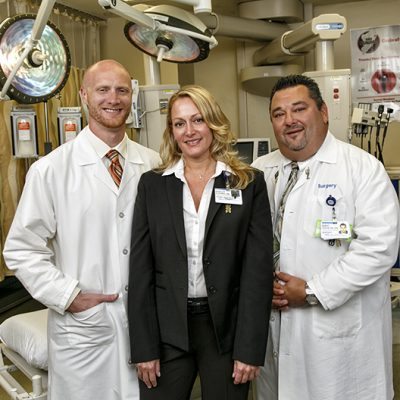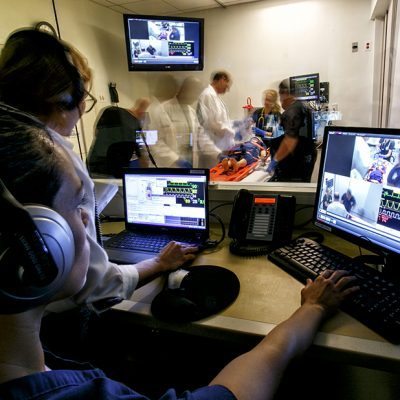
How SIUH has placed itself at the forefront of Critical Care
by Jessica Jones-Gorman Photos by Amessé Photography
The Trauma Center at Staten Island University Hospital is a designated Level I regional trauma center that treats approximately 1,700 significant injuries each year—caring for patients arriving in the Emergency Department and fielding admissions to the Surgical Intensive Care Unit. But for Dr. Stephen Cohn, who serves as director of trauma and surgical critical care for the hospital, each one of these 1,700 cases is personal.
“Our goal is to consistently improve the quality of care given to each injured individual and those who are acutely ill with general surgical problems,” noted Dr. Cohn. “That is our main purpose. From pre-hospital care all the way through to rehabilitation—the entire trauma and critical care process needs to be seamless.”
According to Cohn, the responsibility of his service begins when a patient arrives in the Emergency Department and meets specific trauma criteria. Patients requiring hospitalization are then admitted to a designated trauma unit where their care is supervised by attending surgeons who are board certified in surgical critical care. The most serious cases are admitted to the Surgical Intensive Care Unit (SICU).
“Trauma and Surgical Critical Care is all about a cohesive team, including nurses, nursing assistants, respiratory, occupational and physical therapists, nurse practitioners and physician’s assistants, physicians, and the entire hospital staff working together,” Cohn said.
“Trauma and Surgical Critical Care is unique in that it is all about collaboration—essentially bridging the gap among every medical discipline to achieve the best possible patient outcome. Ranging from emergency medicine to neuro-surgery and orthopedics—and certainly not leaving out EMS and law enforcement—each case is a group effort and every aspect of care is an important step in the process. Pre-operative, inter-operative, and post-operative issues are addressed by different parties. Each group in this equation is an integral part of care.”
Cohn should know. Inspired by his father, a Marcus Welby-brand of family doctor who made house calls from his office in Berkeley, California, he attended Baylor College of medicine before completing his residency at Boston University Medical Center and a trauma and surgical critical care fellowship at Boston City Hospital. He was subsequently named chief of Trauma at Yale University School of Medicine. One month into that position, Dr. Cohn was called to serve in the US Army Medical Corps and was activated in Operation Desert Storm.
“My father was a Navy Corpsman in WWII and my grandfather enlisted in the artillery in WWI, and most of the surgeons I had been working with in trauma had performed their obligation to their country in Vietnam,” Cohn explained. “So I enlisted as an Army reservist and was sent to Saudi Arabia. Teaching trauma surgery for a living, I felt it was important for me to give something back to my country.”
He returned to Yale after his service and was tasked with building back its entire trauma service. In 1997, Cohn assumed the role of medical director of the Ryder Trauma Center, as the Robert Zeppa Endowed Professor of Surgery at the University of Miami, and ran the divisions of Trauma and Surgical Critical Care. In August, 2004, he was appointed chairman of the Department of Surgery at the University of Texas Health Science Center at San Antonio. He began his career with SIUH this June.
“Our aim here is to put together a Trauma Institute where we can share education and research across the North-Shore LIJ system,” said Cohn. “There are strong clinical and education efforts in place here already; we just want to expand upon them, as well as further develop the research program to keep trauma care and critical care sophisticated…on the cutting edge.”
SIUH’s Trauma Center is currently committed to staff education and training, and sponsors courses in Advanced Trauma Life Support (ATLS) for health care providers multiple times a year. A Trauma Nursing Core Course (TNCC) is also offered for Emergency Department nurses. This program, developed and overseen by the Emergency Nursing Association, provides certification in nursing care for the injured patient. The Trauma Center is also involved in community outreach and injury prevention, participating in many community programs to promote the health and safety of the residents of Staten Island.
“There have been many developments in this field, so there are a multitude of ways to improve the process,” Dr. Cohn noted, detailing some trauma centers in the country who have processes in place wherein the car itself actually notifies the EMS system that it has been in a crash.
“In an urban center like Staten Island, where hospital transport times are relatively short, I don’t think that type of process is necessary,” Cohn commented. “But it is an impressive model. Ideally, we like to be notified prior to patients’ arrival, be briefed on the status so we are prepared to receive them, and that type of notification capability is already available.”
“Each place has its own unique challenges,” Cohn concluded. “It’s our job to apply the right skills to those issues. But here at Staten Island University Hospital, we are well equipped and look forward to building upon the excellence in trauma and surgical critical care that has already been established over the years.”
Staten Island University Hospital
475 Seaview Avenue / 718.226.9000 / siuh.edu




